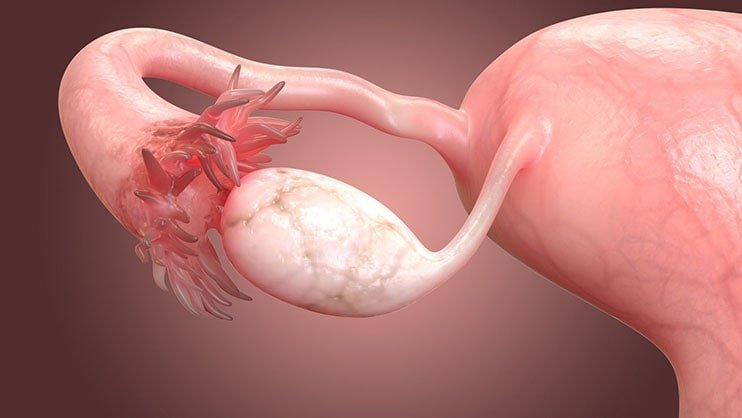World's #1 Ovarian Cancer Specalist in Gurgaon
Ovarian cancer is the cancer which arise from reproductive organs of female. Ovaries are female organs of reproduction, two in number and situated on either sides of uterus. Eggs are produced in ovaries, travel in fallopian tubes and reach uterus for fertilization. Ovaries are main sources of estrogen and progesterone hormones. Apart from ovaries, epithelial cancers can also arise from fallopian tubes and peritoneum.

Burden of Ovarian Cancer:
- Eight most common cancer in India
- Ninth most common cause of cancer related mortality in India
- Average lifetime risk of developing ovarian cancer is 1.38% or 1 in every 72 women.
Types of Ovarian Cancer:
- ● Epithelial Ovarian Cancer : Most common type, >90%
● Stromal Cell Tumors
● Germ Cell Tumors: Most common type of ovarian tumors in children.
Risk Factors
Old age
Obesity
Having no children or late first pregnancy after age 35years
Hormone replacement therapy after menopaus
Family history of ovarian, breast or colorectal cancer
Inherited Gene Mutation -The genes known to increase the risk of ovarian cancer are called breast cancer gene 1 (BRCA1) and breast cancer gene 2 (BRCA2). These genes also increase the risk of breast cancer.
Pregnancy, breast feeding and oral contraceptives has protective effect.
Screening for Ovarian cancer:
Routine screening for ovarian cancer in asymptomatic women is not recommended by USPSTF/ ACS/NCCN. Some institutions advised for ultrasound and CA 125 for high risk cases.
Alarming Signs:
Historically ovarian cancer is called as ‘Silent Killer’ because it produces no or minimal symptoms in early stages. Only 20% of women are detected in early stages. So it is very important to be aware of this hidden enemy and even the mild symptom should not be ignored.
Early satiety/ Quickly feeling full when eating
Bloating/ abdominal distention
Pelvic or abdominal pain
Urinary frequency
Abnormal Bleeding
Swelling in abdomen or Pelvis
Breathlessness and cough caused by malignant pleural effusion
Bowel obstruction caused by abdominal deposits.
Investigation:
History and physical examination are the most important tools. Following tests will help in diagnosis and guiding treatment.
Tumor Markers: CA 125 and HE4 are epithelial ovarian cancer tumor markers. CA 125 is elevated in only around 50% of early ovarian cancers and 80% of advance ovarian cancers. CA 125 is also sometimes elevated in noncancerous conditions like tuberculosis. AFP, b-hCG, LDH are tumor markers of germ cell tumors.
Ultrasound: usually the first test.
CT Scan: Detect ovarian mass and if any metastatic deposits. Very small ovarian masses may be missed even on CT scan. Tumor deposits at distant sites can biopsied to confirm diagnosis. In a case of tumor limited to ovary, biopsy or FNAC is not advised.
MRI/ PET CECT: may be used to assess local and distant extent of disease depending upon clinical situation. But doing these tests in each and every patient and every follow-up is not advisable.
Diagnostic Laparoscopy: sometimes benign diseases like tuberculosis/ endometriosis may have same presentation as cancer and are difficult to diagnose properly. In these cases prior diagnostic laproscopy avoid laparotomy sometimes and give proper diagnosis.
Stages:
I- Limited to vary
II- Spread to nerby Pelvic organs
III- Spread in upper abdomen or retroperitoneal nodes or Primary Peritoneal Cancer
IV- Visceral organs metastasis or thoracic spread or distant organ spread
Treatment:
Surgery: Epitheial Ovarian Cancers are staged surgical. Surgery is main treatment for most of treatable ovarian cancers. Surgery has two important roles of proper staging and Cytoreduction. Optimal removal of all visible disease and potential areas where disease can spread, is the best possible chance of cure and long term control. Surgery is usually initial treatment in early stage tumors and germ cell tumors.
Role of minimal invasive surgery either laparoscopy or robotic is less clear and open surgery is still preferred approach in case of ovarian cancer treatment.
Sometimes surgery is also required for palliation as in case of bowel obstruction in advance disease.
• Chemotherapy: Chemotherapy has improved long term control of cancer a lot. Apart from low grade stage 1 cancer and borderline malignant tumors, adjuvant chemotherapy is usually advised in all patients. In case of extensive disease, when it is considered unresectable upfront, Chemotherapy is started before surgery.
• Targetted therapy and hormone therapy: have role in advance cancers, recurrent cancers.
• Cytoreductive Surgery +HIPEC: is advised in selected recurrent cases and selected stage III cases.
Prognosis:
Stage - 5 year Survival
I - 95%
II - 80-90%
III - 70%
IV - 30%
Combined - around 50%
Contact to the best ovarain cancer doctor in Gurgaon India
Book an AppointmentWhat Our Patients Say
Frequently Asked Questions
Bloated Pelvic or stomach (abdominal) pain. Trouble eating or feeling fast. Signs like urgency (always feeling like you have to go) or frequency (often to leave). Contact Cancer Surgery Gurugram surgery gurugram for ovarian cancer treatment in Gurgaon.
Ovarian cancer can be asymptomatic for many years, making it challenging to diagnose. There is some good news: Overall, the cancer rate has declined over the last 20 years. Contact Cancer Surgery Gurugram surgery gurugram for ovarian cancer treatment in Gurgaon.
Best Doctor for ovarian cancer in gurgaon says the types of ovarian cancer are taken together, with 3 to 4 (72.4%) women suffering from ovarian cancer surviving at least 1 year after diagnosis. Nearly half (46.2%) of women suffering from ovarian cancer are still alive at least 5 years after diagnosis. The diagnosis of women under 65 years of age is better than that of older women.
According to the Best Doctor for ovarian cancer in Gurgaon Transvaginal ultrasound (TVUS) and CA-125 blood test are used 2 times (in addition to a complete pelvic examination) to screen for ovarian cancer. TVUS (transvaginal ultrasound) is a test that uses sound waves to insert an ultrasound stick into the vagina to look at the uterus, fallopian tubes, and ovaries.

